2561Thu 15 Mar 2018 LESSON
Buddha Vacana
— The words of the Buddha —
in20 Classical Danish- klassisk dansk
15 মার্চ মহাজন
হিতৈয়ায় বহুজন সুখায় ইতিহাস - সাহেব জন্মগ্রহণ করেন শ্রী কংসি রাম জি -
ডট্রেডড্ডেন সোসাইটির উত্তরণের জন্য তাঁর কাজ, আত্মত্যাগ এবং সংগ্রামের কথা
মনে রাখুন।
બહુજન હિતાયામાં
15 માર્ચ બહુજન સુખાયા ઈતિહાસ - સાહેબનો જન્મદિવસ શ્રી કાન્શી રામ જી -
તેમના કાર્ય, બલિદાન અને સંઘર્ષના સોસાયટીના ઉન્નતિ માટે સંઘર્ષ યાદ રાખો.
बहुजन हिथया में
15 मार्च बहुजन सुखाना इतिहास - साहेब का जन्मदिन श्री कंजी राम जी - अपने
कार्य, बलिदान और संघर्ष को दलित समाज की उत्थान के लिए याद रखें।
15 ಮಾರ್ಚ್ನಲ್ಲಿ
ಬಹುಜನ್ ಹಿತಯಾ ಬಹುಜನ್ ಸುಖಾಯಾ ಇತಿಹಾಸ - ಸಾಹೇಬ್ ಶ್ರೀ ಕಾನ್ಶಿ ರಾಮ್ ಜಿ ಅವರ
ಜನ್ಮದಿನ - ಅವನ ಕೆಲಸ, ತ್ಯಾಗ ಮತ್ತು ದೌರ್ಜನ್ಯದ ಸೊಸೈಟಿಯ ಉನ್ನತಿಗಾಗಿ ಹೋರಾಟ.
15 മാർച്ച് ബഹുജൻ
ഹിതയ ബഹുജൻ സുഖമാ ചരിത്രമാണ് - സാഹ്ബ് ശ്രീ കൻഷി റാം ജിയുടെ ജന്മദിനം,
അദ്ദേഹത്തിന്റെ ദൗത്യം, ബദ്ധശത്രുക്കൾ, താഴേത്തട്ടിലുള്ള സമൂഹത്തിന്റെ
ഉന്നമനത്തിനായി പോരാടുക
बहुजन हिथयात 15
मार्च बहुजन सुखिया इतिहास - साहेब श्री कन्शी राम जी यांचे वाढदिवस- द
ट्रस्टलडेडन सोसायटीच्या उत्कर्षासाठी त्यांचे कार्य, त्याग व संघर्ष
लक्षात ठेवा.
15 मार्च भुजान
हिथ्य बहादुर सुख इतिहास - साहेब जन्मदिन श्री केन्सी राम जी - आफ्नो काम,
डाउनफ्रर्डेन सोसायटी को उत्प्रेरक को लागि बलिदान र संघर्ष को सम्झना।
ਬਹੁਜਨ ਹਿਤਿਆ ਵਿਚ
15 ਮਾਰਚ ਬਹੁਜਨ ਸੁਖਿਆ ਇਤਿਹਾਸ - ਸਹੇਦ ਦਾ ਜਨਮ ਦਿਨ ਸ਼੍ਰੀ ਕੰਸ਼ੀ ਰਾਮ ਜੀ -
ਡਿਸਟ੍ਰੋਡਡਨ ਸੋਸਾਇਟੀ ਦੇ ਉਤਰਾਧਿਕਾਰ ਲਈ ਉਸ ਦੇ ਕੰਮ, ਕੁਰਬਾਨੀ ਅਤੇ ਸੰਘਰਸ਼ ਨੂੰ ਯਾਦ
ਰੱਖੋ.
15 مارچ بهجن ۾ هيته بهرجن سوحي تاريخ - سهر جي سالگره شري ڪانسي رام کان سندس ڪم، ڊيموڊروڊ سوسائٽي جي ترقي لاء قرباني ۽ جدوجهد.15
மார்ச்
பஹ்யான் ஹித்தாய பஹுயான் சுகாயா வரலாற்றில் - சாகிப் ஸ்ரீ கன்ஷி ராம்
ஜி.ஐ.யின் பிறந்த நாள் - அவரது பணி, தற்காலிகச் சங்கத்தின் மேம்பாட்டிற்கான
தியாகம் மற்றும் போராட்டம்.
15 బహజన్ హితయా
బహుజన్ సుఖాయా చరిత్రలో మార్చి - సాహెబ్ శ్రీ కంషీ రామ్ జి పుట్టినరోజు -
తన పనిని గుర్తుంచుకోవాలి, డౌన్గ్రూడ్ సొసైటీ యొక్క ఉద్ధరణ కోసం పోరాటం.
15 مارچ بھجنان
حدیہ بہجن سخایا تاریخ - سوب کی سالگرہ کاش منشین رام جی - ان کا کام،
قربانی اور جدوجہد کے نیچے ڈراوڈڈنڈ سوسائٹی کے لئے جدوجہد.
On March 15
Sarvajan Samaj celebrates Manyawar Kanshi Ram’s political reform through Techno-Politico-Socio
Transformation and Economic Emancipation for the 99.9% Sarvajan Samaj is
becoming a reality
“We alone can challenge and defeat the casteist, communal and pro-capitalist BJP! Sarvajan Samaj got ready!”
Behanji Mayawati’s clarion call to the BSP in New Delhi to liberate the country from the clutches of fascist rule
If elections are conducted with Ballot Papers the BJP (Brashtachar Jiyadha Psychopaths) will get only 0.1% votes.
http://www.legaldesire.com/man
Manyavar Kanshi Ram & His Legacy- Socio-Legal & Governance Perspective
MANYAVAR SHRI KANSHI RAM (15th March 1934 – 9th October, 2006)
Birth, Parentage, Childhood, Early Education and College Education
Shri Kanshi Ram was born on 15th March 1934. His mother was Mrs. Bishan
Kaur and father was Shri Hari Singh. He belonged by birth to Ravidassia
(Ad-Dharmi/Mulnivasi) Sikh community of the Scheduled Castes which is
the largest group in Punjab. Ravidassias have monotheistic belief based
on teachings of 14th century Indian saint, Ravidas, revered as Satguru
by his followers. Ravidass, a Scheduled Caste by birth, taught
monotheistic spirituality and a message of equality and emancipation
from the caste system. Ravidassia’s believe that since Ravidas lived
before the 1st Sikh Guru and his teachings were studied by the Sikh
Gurus and influenced them, he is just as much a saint as them. Initially
the Ravidassias revered the Guru Granth Sahib of the Sikhs, which was
the only repository of the devotional poetry of saint Ravidas. However,
following their drift from mainstream Sikhs, the Ravidassias compiled
their own holy book “Amritbani” comprising of the teachings of Saint
Ravidass Ji, and many Ravidassia temples now use this book as a scared
book.
The place of birth of Shri Kanshi Ram was Pirthipur Bunga
village, Khawaspur in Rupnagar (Ropar District) of Punjab. As per the
information available his father was a literate person and was
interested in ensuring that his children stand educated. Kanshi Ram had
two brothers and four sisters. He was the eldest and best educated. It
is said that he was named Kanshi Ram, as the nurse put the child in the
auspicious bronze tray after his birth. Bronze alloy is known as “Kansa”
in local dialect. His father owned some land and his uncles were in the
armed forces. The early childhood of Kanshi Ram was as usual. He got
his early schooling and passed school classes successfully. He was
talented and meritorious. He got admission in Bachelor of Science
(B.Sc.) program in 1955 in Government College, Ropar, which was
affiliated to Punjab University. He successfully completed this
difficult program in 1956 of science studies in those days when the
facilities were very less. In his own words which reflect the truth “I
was born and brought up amongst those who sacrificed themselves but
never betrayed the country…” His upbringing was modest. During his
school and college years there was nothing special about him to suggest
that he would mature into great social revolutionary.
Initial Placements and Jobs
He was appointed as Scientific Assistant in Explosive Research and
Development Laboratory (ERDL), Pune in 1957. Kanshi Ram joined High
Energy Materials Research Laboratory (HEMRL), and then became part of
the Defence Research and Development Organisation (DRDO) in Pune. During
his tenure in the DRDO in 1965 he joined the agitation started by
SCEWASTAMB (All India Federation of Scheduled Caste/Tribes Backward
Class & Minorities Employees Welfare Associations) of Government of
India.
The Turning Point
Reaching Maharashtra was a turning
point in the life of Shri Kanshi Ram. It was in Maharashtra that he got
influenced by the legacy of dedicated reformers like Mahatma Jyotiba
Phule, Chatrapati Shahuji Maharaj and Dr. B. R. Ambedkar. Here he
started reading the literature related to him and exposure of the impact
of the efforts of Dr. Ambedkar. His personality was now getting
articulated. It was after he joined the struggle against the abolition
of Ambedkar’s birthday as a holiday, in 1965, that his career in the
fight for the oppressed communities started. He studied the entire caste
system and the works of Ambedkar closely and came up with many efforts
to help the oppressed rise from the difficulties of caste
discrimination.
THE REAL BIRTH OF SHRI KANSHI RAM (AS WE KNOW AND AS HISTORY WILL KNOW HIM)
Famous Deena Bhan Case
Shri Deena Bhan was from Rajasthan and belonged to a Scheduled Caste.
He was an employee and senior colleague of Shri Kanshi Ram. He was
suspended. His fault was that he protested against the decision of the
management of ERDL, Kirki, of the cancellation of holidays for Dr. B. R.
Ambedkar and Gautam Buddha Jayantis and their replacement by the Tilak
Jayanti and one additional holiday for Deepavali. Shri Kanshi Ram
decided to fight against such a caste ridden and arbitrary behavior of
the management. The fighter in Shri Kanshi Ram got the suspension orders
of Shri Deena Bhan revoked and Dr. Ambedkar and Buddha Jayanti holidays
were restored.
This was the beginning of the long battle for the
emancipation of the Depressed Classes in the country that Shri Kanshi
Ram led. He resigned from his job and totally dedicated his entire life
for the cause of the community. He declared “I will never get married, I
will never acquire any property, I will never visit my home, and I will
devote and dedicate the rest of my life to achieve the goals of Phule-
Ambedkar Movement”. He never married nor visited his home since then.
His struggle was not for the home and family. He devised a new strategy
to regain the glory of the original (Adi) inhabitants of Bharat (India).
These pledges reflect the work of Manyavar Kanshi Ram who is remembered
in the history of India as a true leader of Bahujan Samaj.
SOCIO-CULTURAL LEGACY OF MANYAVAR KANSHI RAM
Identification, Expansion, Inclusion and Recognition of Other Backward Classes, Minorities and Others as Depressed Classes
The journey of Manyavar Kanshi Ram and his movement of socio-cultural
revolution and economic emancipation of Bahujan Samaj started way back
in 1964. Significantly, he expanded the circle of the Depressed Classes
by incorporating other Backward Classes and Minorities into it. He
criticized the post- Ambedkar leadership of Scheduled Castes in India.
He gave utmost importance to the culture of work and democratic method
of struggle.
In 1971 he quit his job and together with his
colleagues established the Scheduled Castes, Scheduled Tribes, Other
Backward Classes and Minorities Employees Welfare Association. The
Association was registered with the Charity Commissioner, Pune. Through
this association, attempts were made to look into the problems and
harassment of the employees and bring out an effective solution for the
same. Another main objective behind establishing this association was to
educate and create awareness about the caste system. This association
turned out to be a success with more and more people joining it.
Criticism of Poona Pact and Post Ambedkar Scheduled Caste Leadership
Kanshi Ram was critical of the Poona Pact(September 24,1932) and he
examined it in great depth. He said that “Poona Pact” made Scheduled
Castes helpless. By rejecting separate electorate, Scheduled Castes were
deprived of their genuine representation in legislatures. In his famous
book “The Chamcha Age” (An Era of the Stooges) he exposed various kinds
of Chamchas (Sycophants or Stooges). He was of the opinion that many
kinds of sycophants were born in the last fifty years. As and when
India’s so called high caste Hindu rulers felt the need of sycophants
and when the authority of the upper castes got endangered by real and
genuine Scheduled Caste leaders, sycophants were brought to the fore in
all other fields. In his popular work “The Chamcha Age”, a well argued
tirade against the pseudo Scheduled Caste leaders, Kanshi Ram Ji
sharpened the claim for the legitimate acquisition of political power by
the downtrodden in electoral democracy of India. He focused on the
Poona Pact which was a decisive victory of Gandhi over Dr. Ambedkar
after a long struggle between the two at the Round Table Conference.
In the mid 1960s, Kanshi Ram Ji started organizing government employees
of Scheduled Castes community to fight against deeply entrenched caste
system. It was around this time that he decided to dedicate his life to
the cause of the emancipation of Depressed Classes. Finally he decided
to carve out a crucial role of Depressed Classes in the politics of the
country. He witnessed the failure of Ambedkarite Movement in
Maharashtra.
After the death of Dr. Ambedkar, The Republican
Party of India (R P I) as visualized by Dr. Ambedkar was formed on 3rd
October, 1957. It had its roots in the Scheduled Castes Federation led
by Dr. B. R. Ambedkar. But from 1958 the party began to split up under
various leaders. The biggest set-back to the party was that, it became a
party of Maharashtra and the Mahars (later converted to Buddhism after
1956) and the other sub-castes remained the supporters of Congress and
others. The clash of personalities and personal political ambitions took
the mission in a reverse direction rather taking it ahead.
Kanshi Ram Ji noticed the vitality of Dr. Ambedkar’s movement. He
started working with Republican Party of India. After about eight years
of active association with Republican Party of India, he became
disillusioned with its functioning. His dream of Ambedkarite movement
was shattered when Dadasaheb Gaikwad joined hands with Late Shri Mohan
Dhariya of Congress for a Lok-Sabha reserved seat. He observed that
supporters of RPI were celebrating the pact of RPI and Congress whereas
RPI got just one seat and remaining seats were given to Congress. This
event was the beginning of his dissociation from Republican Party.
Kanshi Ram Ji decided that he will develop a society which will work to
spread the thoughts of Dr. Ambedkar and other social reformers and will
never sell themselves for a small gain. He independently started
organizing the employees of Scheduled Castes, Scheduled Tribes and Other
Backward Classes mainly from Pune, Bombay, Nasik, Nagpur and Delhi. He
traveled all over the India along with his few activists to know why the
mission of Dr. Ambedkar was brought back rather than taking ahead.
During these days he never bothered about his health, food and transport
working tirelessly to awaken the educated employees. The organization
of employees of Backward Class and Religious Minorities, after doing the
necessary work within a period of five years, decided to float an
organization in 1973. As a result of this, and as per the vision of Dr.
Ambedkar, Kanshi Ramji started his first organization on 6th December
1978 in Delhi, called as BAMCEF.
In fact the BAMCEF (All India
Backward (SC, ST, and OBC) and Minority Communities Employees’
Federation) was an association in the beginning and was launched in 1971
and it finally became a federation in 1973. In 1973 it was a purely non
political, non religious & non agitating organization. The first
operating office was opened in Delhi in 1976 with the motto to “Educate,
Organize and Agitate”. This served as a base to spread the ideas of
Ambedkar and his beliefs. Manyavar Kanshiram worked with dedicated
colleagues like Shri D. K. Khaparde, Deena Bhan, Shri Ram Khobragade,
Shri C.P.Thorat, Shri Namdevo Kamble and others to build the initiative.
After five years of rigorous fieldwork all over India, a convention was
held in Delhi in 1978 and the organization was officially launched as a
“Federation” on 6th December 1978 on the death anniversary of Dr. B. R.
Ambedkar, the Architect of Indian Constitution.
BAMCEF’s stated
mission is to establish and fortify the non-political roots of the
Mulnivasi Bahujan Samaj in order to change the Brahmanical Social System
of inequality i.e. traditional Indian social system based on castes and
varnas. The organization, which celebrated its silver jubilee in 2008,
upholds an ethos that states that the victims of systemic inequality in
India are, naturally, the only people who can uproot the existing social
structure. Subsequently, he formed Buddhist Research Center (BRC), DS-4
and BSP.
Kanshi Ramji decided to take the mission of Dr Ambedkar
ahead as he considered it as his responsibility. Then he started
working among educated employees and awakening them to work for the
emancipation of the downtrodden. In this process he was successful to a
large extent in awakening, realizing and transforming the expectations
of Dr. Ambedkar from educated classes. After the necessary ground work
and positive response from some employees in Pune, Nagpur, Delhi and
other places Kanshi Ram Ji decided to launch an organization. Thus, the
idea of BAMCEF was conceived in 1973. After ceaseless field work
throughout the country for nearly about five years the birth of BAMCEF
took place on the lawns of Boat Club in New Delhi, on 6th December 1978.
During this time, he conducted several cadre camps, meetings and
seminars in different parts of the country to awaken the employees. The
basic aim of BAMCEF was to develop genuine and capable leadership among
the oppressed. It has been the organization aimed to build up the
non-political roots for the success of Dr. Ambedkar’s political vision
and action. The first concept given by Kanshi Ram Ji was “people who
should succeed politically must have strong non-political roots”
Kanshi Ram Ji had realized that the people whose non-political roots
were not strong were bound to fail politically. They can have their
political party, but they cannot succeed politically. Therefore, in
order to strengthen the non-political roots of backward class people, he
began BAMCEF experiment and spent about a decade in organizing the
educated employees of SC/ST/OBCs and Minorities, who were benefited by
the policy of reservation. BAMCEF created a new missionary political
conscience among the backward caste educated employees and also
established a national network to further the movement.
Kanshi
Ram Ji did not project himself a leader but worked silently as an
organizer and hence did not mind to invite Ram Vilas Paswan Ji and the
legendary Shri Karpoori Thakur Ji to address 3rd National Convention of
BAMCEF which was held in Chandigarh between 14th -18th October 1983.
After investing about two decades of his youth Kanshi Ram Ji realized
that merely organizing employees would not be enough to fulfill the
dreams of Dr. Ambedkar unless they get power and become rulers.
Therefore, he gave another concept, i.e. ‘Power will be the product of
struggle’. He realized that employees cannot undertake a sustained
struggle. So he established Dalit Shoshit Samaj Sangharsh Samiti (DS-4)
on 6th December, 1981 as a parallel organization to the BAMCEF. It was
created to fight against the attacks on the workers who were spreading
awareness on the caste system. It was created to show that workers could
stand united and that they too can fight. However this was not a
registered party but an organization which was political in nature.
POLITICO-ECONOMIC ASPECTS
According to Kanshi Ram Ji, “It’s not that our people were not
struggling, they were struggling but not for themselves. They were and
are struggling for somebody else as stooges. Because we are passing
through the Chamcha Age or the era of stooges, and as stooges we are
struggling”.
Kanshi Ram Ji in his historical book, “The Chamcha
Age”, (the Era of the Stooges) published on 24th September, 1982, on the
occasion of 50th anniversary of the Poona–Pact, has vividly and
exclusively dealt with the disadvantages of the Chamcha Age. He has
classified the stooges in different categories i.e. (A) (1) Caste and
Community-wise Chamchas like The Scheduled Castes or Reluctant Chamchas,
(2) The Scheduled Tribes or Initiated Chamchas (3) The Other Backward
Castes or the Aspiring Chamchas (4) The Minorities or Helpless Chamchas
(B) Party–Wise Chamchas (C) Ignorant Chamchas (D) Enlightened Chamchas
or Ambedkarite Chamchas (E) Chamchas of the Chamchas (F) Chamchas
Abroad.
Kanshi Ram Ji was very clear in understanding the Poona
Pact and therefore he had said that Babasaheb Ambedkar wanted to take
the down trodden from Dark Age to Bright age. But Gandhi Ji intervened
in this process of change. Hence we entered into a different age then
onwards, which I have named as the age of Chamchas or the Chamcha Age or
the Era of Stooges. His only book deals with the Chamcha Age phenomenon
in detail.
In his scientific analysis of the Chamcha Age, he has
focused on the fall of Ambedkarism from the first general election i.e.
from 1951 till 1980. In 1971 due to alliance between R P I and
Congress, his all hopes of Ambedkarite Movement dashed. Therefore,
following the advice of Dr. Ambedkar i.e. ‘political power is the key to
all social progress,’ he felt absolutely essential for the members of
all oppressed and exploited communities to prepare themselves for
agitation and political action.
From the day of launching D -S4, a
wing of BAMCEF for agitation and awakening, till the formation of
Bahujan Samaj Party, on 14th April, 1984, Kanshi Ram Ji conducted
several experiments of social action across the country successfully.
The programs created sufficient awareness in the Bahujan Samaj about
their socio – political, economic and cultural status. Hence, D-S4
proved as a milestone in the preparation for the long battle of
political action, social transformation and economic emancipation.
Ambedkar Mela
Kanshi Ram Ji continued building his network and making people aware of
the realities of the caste system, how it functioned in India and the
teachings of Ambedkar. Wherever he travelled he did the same and had
many followers. In 1980 he created a road show named “Ambedkar Mela”
which showed the life of Ambedkar and his views through pictures and
narrations.
POLITICAL LEGACY OF MANYAVAR KANSHI RAM
He
started his efforts of consolidating the Depressed Classes vote in 1981
and on April 14, 1984 he founded a full-fledged political party known as
the Bahujan Samaj Party (Common Man’s Party). The BSP found success in
Uttar Pradesh but struggled to bridge the divide between Scheduled
Castes and the Other Backward Classes.
Social Reformer turning into a Political Reformer
In 1986, Manyavar declared his transition from a social worker to a
politician by stating that he was not going to work for or with any
other organization other than the Bahujan Samaj Party. During the
meetings and seminars of the party, Shri Kanshi Ram stated to ruling
classes that if they promised to do something, it would pay to keep the
promise, or else just accept that they were not capable of fulfilling
their promises.
In an interview posted by Shri Prem Kumar
Chumber, in answer to a question that why he was hostile to all the
national parties, especially the communists? Shri Kanshi Ram replied
that to his my mind, all parties represent the forces of status quo. For
us, politics is the politics of transformation. The existing parties
are the reason for the status quo. That is why there has been no upward
mobility for the backward communities. The communist parties have become
the biggest stumbling block in this regard. They keep talking about
change, but work for status quo. The BJP is better, they never talk
about change. So people never feel duped. Parties like the Congress and
Communists talk about abolishing poverty, but work towards keeping
people poor. If the poor are not kept poor, these people cannot remain
in their seats.
When the question was asked as to why on the
occasion of the Centenary of Congress, Shri Arun Singh said your
emergence was not healthy for the national ethos. Kanshi Ram Ji replied
that he is the grandson of a Maharaja who never kept the interests of
the nation in mind. Nationalism to him is feudalism. Nationalism to me
is the masses of India. I believe in two nation theory i.e. those who
oppress and those who are oppressed. What does the grandson of a
Maharaja knows about nationalism? What can we expect from Arun Singh
than such things?
Further when he was asked as to why his party
cadre is so hostile to Mahatma Gandhi? Kanshi Ram Ji replied that Gandhi
is at the root of everything. I want change. Dr. Ambedkar wanted
change. But Gandhi was the custodian of the status quo. He wanted
Shudras to remain Shudras. Gandhi worked to keep the nation divided .We
are working to unite the nation and to erase all artificial divisions.
When asked why his movement took so much time to become a reality?
Kanshi Ram explained that up to 1971, he was not so much interested. He
was working with RPI. Then he found that he was marching towards a ship
that others were deserting .It took a long time to prepare himself and
others. He had to collect lot of information, so that he could know how
to prepare society and build a cadre. Preparing society took a long
time.
When asked that how can he abolish caste by floating a
party based on caste? Kanshi Ram explained that BSP is not a party
upholding caste. If it is uniting six thousand castes, how can it be
called a party upholding caste? The upper castes say why not include us.
I say you are leading all the parties. If you join our party, you will
block change here also .The upper castes can join the party, but they
cannot be its leaders. Leadership will remain in the hands of the
backward community. My fear is that these upper caste people will come
into our party and block the process of change. When this fear goes,
they can join our party.
He also explained that he represents the
constituency of Babu Jagjivan Ram and Chaudhary Charan Singh and may be
to some extent, Sayed Shahabuddin. Kanshi Ram asked the Depressed
Classes in a special speech delivered by him in 1st World Dalit
Convention in Kuala Lumpur, Malaysia which was held between 10th &
11th October, 1998 that instead of being ruled let us be the rulers.
He unsuccessfully contested from East Delhi (Lok Sabha Constituency) in
1991 and came at fourth position. As a politician, gradually he became
popular among his people, who found a new hope and vision in his efforts
and sincerity. Gradually he became a prominent figure and a force to be
reckoned in politics. He was a successful strategist and a meticulous
organizer. He used quite often a combative and aggressive strategy with
offensives on other political parties which he claimed only represented
the interests of higher caste Hindus. He was different from other
politicians of the mainstream. He used to communicate and interact with
people before he spoke. In 1996 Kanshi Ram Ji was elected to the Lok
Sabha from the Hoshiarpur constituency. The significance of this
territorial area was that from there fifty years ago Baba Mangu Ram Ji
(1886- 1980), a noteworthy freedom fighter associated with Ghadar Party
& founder of Ad Dharm Movement in Punjab , dedicated to attaining
equality for untouchables, was elected to the Punjab Assembly in 1946 .
Ad-Dharm Movement was very successful in this region and this also got
reflected in the mandate. He was from Scheduled Castes community and had
pioneered the Scheduled Castes Movement in colonial Punjab. Hoshiarpur
was a strong hold of “Ad Dharm”.
Bahujan Samaj Party (BSP)
celebrated the 75th year of the “Ad Dharm Movement” on 18th February,
2001. On this occasion Kanshi Ram Ji asked the Bahujan Samaj to follow
the principles of the “Ad Dharm Movement”. Kanshi Ram Ji believed that
an unstable government at center is beneficial for Bahujan Samaj as
maximum advantages can be derived in this situation for deprived
sections. Therefore he used say frequently,” I want a Majboor (weak)
government at centre and not Majboot (strong) till we reach to the
political power in the Centre”. Kanshi Ram Ji articulated the Bahujan
ideology from Buddha to Ambedkar. Kanshi Ram Ji always acknowledged the
contribution of Mahars now Buddhists by and large for supporting Dr.
Ambedkar in his war against Manuvadi system. Kanshi Ram Ji consistently
led his movement for almost four decades from 1965 to 2003 till his
illness. In 2001 he publicly announced Mayawati Ji as his successor.
Mayavati Ji considers Manyavar Kanshi Ram as her Mentor. She has served
Uttar Pradesh as the Chief Minister four times. She took up the
unfulfilled dream of Manyawar Kanshi Ram Ji and has proved to be the
worthy successor of Kanshi Ram Ji’s socio-political struggle when she
became the Chief Minister of Uttar Pradesh for the fourth time with an
absolute majority in May 2007.
ANNOUNCEMENT FOR CONVERSION TO BUDDHISM
In 2002, Kanshi Ram ji announced his intent to convert to Buddhism on
14th October 2006, the fiftieth anniversary of Dr. Ambedkar’s conversion
to Buddhism. He intended that about 20,000,000 of his supporters will
also convert at the same time. Significance of this plan was that the
followers of Kanshi Ram Ji included not only untouchables but also
persons from a variety of castes, who could significantly broaden
Buddhism’s support. But, he died on 9th October 2006. Mayawati Ji his
successor said “Manyavar Kanshi Ram and I had decided that we will
convert and adopt Buddhism when we will get “absolute majority” at the
Centre. We wanted to do this because we can make a difference to the
religion by taking along with us millions of people. If we convert
without power then only we two will be converting. But when you have
power you can really create a stir”.
MANYAVAR KANSHI RAM’S NIRVAN
The health of Manyavar was gradually deteriorating. He was already a
diabetic and had suffered a heart attack in 1994 followed by the
formation of a clot in a brain artery in 1995. He suffered a brain
stroke in 2003. From 2004 onwards, Kanshi Ram stopped appearing publicly
as he was suffering from various health problems. He convalesced at the
home of Ms Mayawati Ji. On 9th October 2006, he died of a severe heart
attack in New Delhi. Kanshi Ram ji was virtually bed-ridden for more
than two years. According to his wish, last ritual was performed as per
Buddhist tradition, the pyre of Manyavar Kanshi Ram was lit by his sole
heir Mayawati. His ashes were placed in an Urn and kept at Prerna Sthal,
with huge procession accompanied by lacs of supports.
The body
of Kanshi Ram was consigned to flames with Buddhist rituals. The last
rites were performed in the presence of his two brothers and sister. BSP
President Mayawati personally supervised the last journey of her
mentor. Earlier, the body was brought to the party office around 01 P.M.
and kept there for an hour for people to pay homage. Several national
and state leaders, including the then Chief Minister of Delhi Mrs.
Sheila Dikshit, paid their tributes at the BSP office. Then the body,
wrapped in the tricolor, was taken to the Nigam Bodh Ghat in a glass
casket mounted on a flower-decked vehicle. The cremation took place
around 04 P.M. During the funeral procession, party workers and
followers raised slogans hailing Kanshi Ram as “the leader of the
Depressed Classes.” A group of Buddhist monks accompanied the
procession.
Vice-President of India Shri Bhairon Singh Shekhawat,
Congress President Mrs.Sonia Gandhi and Vice President and Mr.Rahul
Gandhi, the former Prime Minister I.K. Gujral, and Bharatiya Janata
Party leader Sushma Swaraj were present at the funeral. Sonia Gandhi
As per Kanshi Ram’s wishes, his mortal remains were not immersed in any river but kept in the BSP offices in Delhi and Lucknow.
MAYAWATI AND THE SECOND SOCIO-CULTURAL REVOLUTION IN UTTAR PRADESH
According to Learned Prof. Ronki Ram, with the swearing in of Ms.
Mayawati, the BSP Chief, as Chief Minister of Uttar Pradesh for the
fourth time on 13th May, 2007 the second socio-cultural revolution has
begun in the history of Uttar Pradesh. During the medieval Bhakti
movement Guru Ravi Dass, an untouchable poet-saint of very high repute
had convinced the Brahmins that it was not caste but ones deeds which
are important. Brahmins and Rajput Kings prostrated before him and Ranis
and Maharanis of the then rulers and the rulers themselves became his
followers. It seems that history was repeating itself when Brahmins and
Thakurs among others were touching the feet of BSP Chief Mayawati during
the swearing-in ceremony of the new cabinet in Lucknow. Once again
Mayawati has proved that hollow prestige based on birth when put to
trial in the democratic court of social justice it failed to stand any
more. The new form of combined rule of ‘Sarvajan’ under the leadership
of the Depressed Classes is certainly an advancement not only over the
tight rope walk of the coalition government system that India has been
experiencing for the last many years, but also a new beginning of the
coming of the marginalized into the center stage of power politics.
Prof. Ronki Ram further analyzes that Mayawati’s Dalit-Brahmin thesis
and her emphasis on “Sarv Samaj” coupled with the social engineering
formula would facilitate in laying down parameters for the mitigation of
the gap between what Baba Sahib Dr. Ambedkar said, “political equality
and social and economic inequality” in India. This new system of
‘Sarvjan combined rule’ would certainly help in deepening of the roots
of democracy in India and inculcating positive feelings among the
downtrodden that they too matter in this land where they were for
centuries kept socially excluded, politically marginalized and
economically deprived. Now they feel encouraged to come forward not to
plead or ask for favors because they were neglected but because they are
able to provide leadership to safely steer the ship to its destination.
Mayawati Ji is right when she said that behind her great victory is the
philosophy of Phule, Naryana Guru, Periyar, Dr. B. R. Ambedkar, and
Manyavar Kanshi Ram. In fact, it is she who tried to put this philosophy
into action and translated it into reality. Whether the Savarnas were
falling at the feet of Mayawati Ji out of gratitude or of political
expediency is not the point. The real point is that by putting the
Brahmins and Thakurs in line and commanding respect, Mayawati Ji has
been able to evaporate the Lakshman Rekha of Varnashram Dharma. She has
set the ball of self respect and dignity of the so called Avarnas
rolling. She brought the Savarnas and Avarnas on a single platform, of
course, led by her. What is even more important is that she achieved all
this through democratic way and people of all castes stood by her in
her battle against social repression. In fact, this is not in any case
less than a social revolution. This revolution needs to be replicated in
other parts of the country too, if India really wants to shine as a
world power in near future. If India wants to march ahead, social
exclusion has to end first. Untouchability is not a problem of the
Shudras only, it is the number one problem of the entire Indian society.
It needs to be tackled immediately. Dr. B.R. Ambedkar sounded a grave
warning on 25th November, 1949 in the Constituent Assembly on the
completion of the Draft Constitution, “On 26th January 1950, we are
going to enter into a life of contradictions. In politics we will have
equality and in social and economic life we will have inequality… We
must remove this contradiction at the earliest possible moment or else
those who suffer inequality will blow up the structure of political
democracy which this Assembly has so laboriously built up”. The struggle
has to continue.
A WORTHY CASE FOR BHARAT RATNA
The credit
of taking social justice to the door steps of the poorest of the poor
through peaceful means goes to Manyavar Kanshi Ram Ji in post
Constitutional Era. This has made economic justice also to travel in the
same direction. Further, this type of socio-economic contribution to
the national life has made political justice also a reality. This
unparalleled contribution and a unique approach to inclusiveness by
bringing all the Depressed Classes together as Bahujan Samaj makes him
worthy of ‘Bharat Ratna’ the highest civilian award of India to be
awarded to him.
CONCLUSIONS AND SUGGESTIONS
In the light of
analysis of the facts and interpretations presented above it is vividly
clear that the efforts of Manyavar Kanshi Ram Ji took the struggle of
the emancipation of the Depressed Classes to the logical conclusion and
he represents himself as one of the leading lights of the movement of
the Depressed Classes in post independence era. His clear vision and
practical approach has made the Depressed Classes as major stake holders
in the political governance of the country. He ensured that the
Depressed Classes reach the helm of political power through democratic
means and methods. He was one of the few noteworthy leaders of
independent India who expanded the frontiers of the politics of
Depressed Classes. His political vision was not confined to Scheduled
Castes only. The political organizations he founded were meant for all
the downtrodden like SC, ST, OBC and the Minorities. It would be
justified to say that he took the lead in making Indian democracy
practically open to the Depressed Classes. The energy liberated by his
movement and efforts will become the real synergy in the national
development. Indian democracy is becoming inclusive in the real sense.
He was a great socio-political leader who could launch and control his
socio-political movement successfully from beginning to end, which is
very difficult and a great quality and requirement of a leader of
masses. His legacy will keep on inspiring the nation in times to come.
GRATEFUL ACKNOWLEDGEMENT
In the preparation of this research paper I have consulted many
sources. Most of them have been acknowledged in the paper. But to study,
understand and write on a leader like Manyavar Kanshi Ram Ji is a
stupendous task. In this process I am indebted to a large number of
sources of information which a person gathers during the journey of his
life. I express my gratefulness to unquoted sources also.
Disclaimer: : This Article Has been Published in Legal Desire
International Journal on Law, ISSN 2347-3525 on Page no 3 and Issue
no.8th
About Author:
Prof. (Dr.) Alok Misra, Dean School of Legal Studies, Apeejay Stya University
Prof. Alok Misra is Dean of the School of Legal Studies, Apeejay Stya
University and is Professor of Constitutional Law from India. He has
teaching, research, administrative and practicing experience of more
than three decades. He was the Founder and Chairman of Human Rights
Organization and an Associate Member (Indian Section) of Amnesty
International (London). Prof. Misra is a Life Member (Non-Practicing) of
the Supreme Court Bar Association, Indian Society of International Law
and the Indian Law Institute, New Delhi. He has been a Member of
International Council of Jurists, London. He is a Consultant in the
field of Constitutional Law. He is a Fellow of The Institute of
Constitutional and Parliamentary Studies, New Delhi.
SHRI KANSHI RAM (15th March 1934 – 9th October, 2006) Birth, Parentage,
Childhood, Early Education and College Education Shri Kanshi Ram…
https://www.indiatvnews.com/…/
Rare pictures of Mayawati and Kanshi Ram
New Delhi: The four time chief minister of Uttar Pradesh Mayawati and
founder of Bahujan Samaj Party, Kanshi Ram shared a perfect
mentor-disciple relation when Kanshi Ram who founded the BSP in 1984.
Impressed by
New Delhi: The four time chief minister of Uttar
Pradesh Mayawati and founder of Bahujan Samaj Party, Kanshi Ram shared
a perfect mentor-disciple relation when Kanshi Ram who founded the BSP in 1984.
Impressed by Mayawati’s innovative ideas and speaking skills, Kanshi
Ram gave her a prominent role in BSP. A municipal school teacher,
Mayawati was preparing for IAS exam, when she met Kanshi Ram.
Kanshi Ram who had just left his job in Nagpur working in the Defence
Ministry advised her to plunge into politics instead of becoming a
bureaucrat. He is supposed to have told her, you want to become an IAS
officer, the day will soon come when IAS officers shall be at your beck
and call. And, Kanshi Ram’s words proved true.
There was no
looking back for Mayawati after that. She worked for the BSP and DS4,
the outfits floated by Kanshi Ram, and became very close to her mentor
till his death.
Here are a few pictures from the past of Mayawati and Kanshi Ram.
Delhi: The four time chief minister of Uttar Pradesh Mayawati and
founder of Bahujan Samaj Party, Kanshi Ram shared a perfect
mentor-disciple relation
https://drambedkarbooks.com/20
https://drambedkarbooks.com/…/
15th March in Bahujan Hitaya Bahujan Sukhaya History – Saheb Kanshi Ram Ji’s Birth Anniversary
also – Few rare pictures of Behan Mayawati and Sahib Kanshi Ram Ji
Watch – Documentary on Saheb Kanshi Ram Ji Read also – What BSP and
Kanshi Ram have done to the Untouchabl…




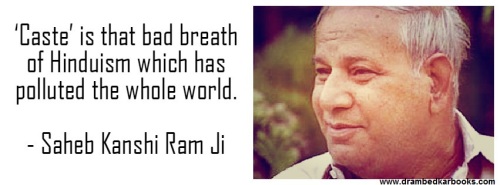






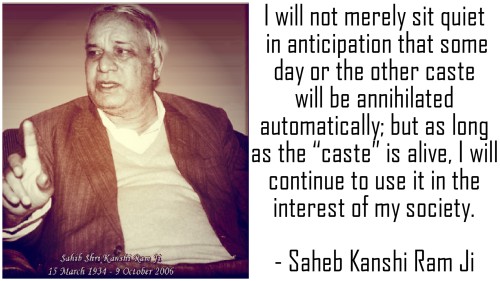
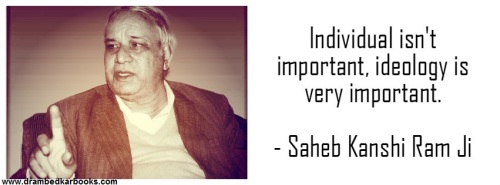





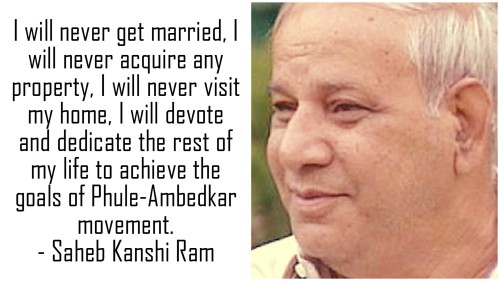
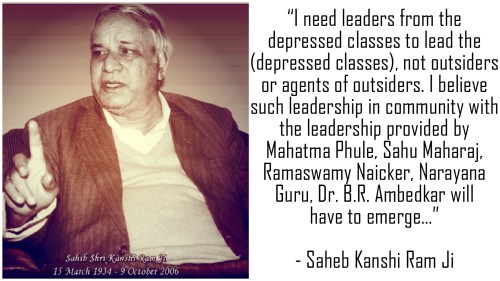
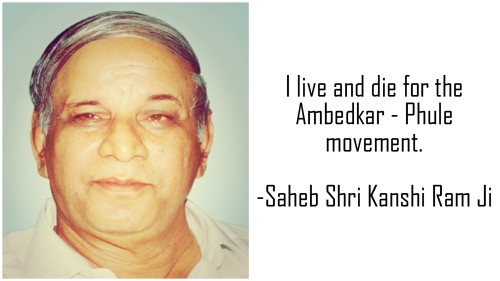
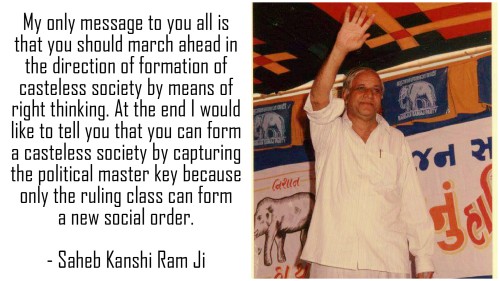
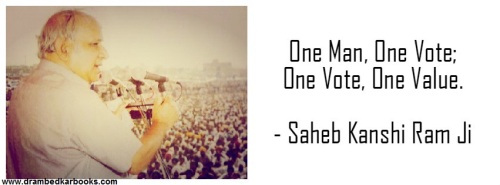

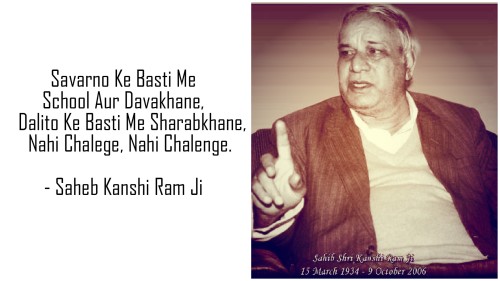

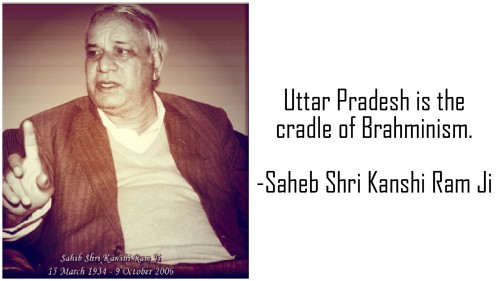

So
what do we do till the time caste is not annhiliated completely ? I
believe until the time we are not able to form a casteless society, we
need to use caste to annihiliate caste. If brahmins can use caste for
the benefit of their society then why can not we use caste to for the
benifit of our society ? - Saheb Kanshi Ram Ji
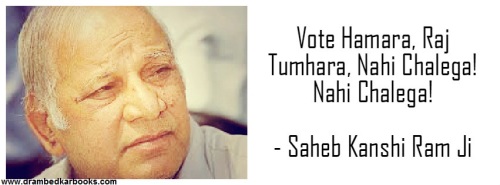
Vote Hamara, Raaj Tumara ; Nahii Chalega,Nahii Chalega - Saheb Kanshi Ram Ji

Vote Hamara, Raaj Tumara ; Nahii Chalega,Nahii Chalega - Saheb Kanshi Ram Ji
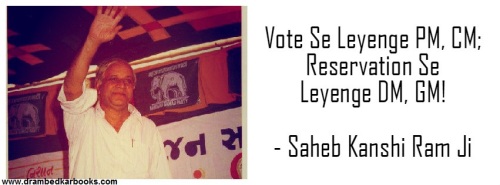
Vote Se Layenge CM, PM ; Reservation SeLayenge DM, GM!- Saheb Kanshi Ram Ji
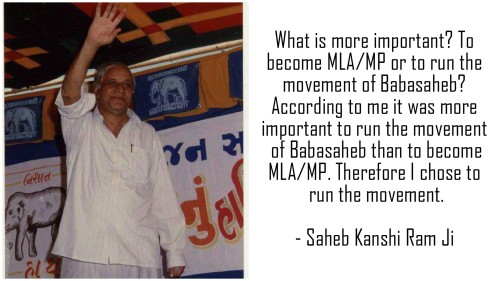
What is more important ? To
become MLA/MP or to run
the Movement of Baba Saheb?
According to me it was more important
to run the movement og Baba Saheb
than to become MLA/MP, Therefore
I chose to run the movement. - Saheb Kanshi Ram Ji
https://timesofindia.indiatimes.com/city/lucknow/sp-bsp-chemistry-stumps-bjp-maths/articleshow/63309403.cms
comfortable in both seats, by about 1.4 lakh vote margins in each case.
Instead, it lost by almost 59,500 votes in Phulpur and nearly 22,000
votes in Gorakhpur. Clearly there was more than arithmetic at work here.
(T)he BJP’s votes came down to 4.3 lakh in Gorakhpur and 2.8 lakh in
Phulpur, but it cannot explain how the combined SP-BSP votes went up by
almost 54,000 in Gorakhpur at a time when the total votes polled
actually fell by over a lakh.
data suggests arithmetic didn’t decide the polls. In 2014, the BJP had
polled 2.6 lakh votes in Araria and the JD(U) 2.2 lakh. Their combined
tally was thus 4.8 lakh, which should have been enough to beat the RJD’s
tally of 4.1 lakh by about 75,000 votes. Yet, the RJD retained the seat
with a comfortable margin of nearly 62,000 votes. Again, this suggests a
swing away from the NDA towards the RJD-Congress combine.
Jahanabad assembly constituency too, the RJD defied the arithmetic to in
comfortably. Comparing with the 2015 assembly elections is not
possible, since the alliances have completely changed since. A
comparison with 2014, however, shows that BJP ally RLSP got over 62,000
and JD(U) nearly 17,000, which should have been enough to give NDA a
margin of almost 23,000 since RJD had got only about 56,000 votes.
Instead, RJD has won by 35,000.
SP-BSP chemistry stumps BJP maths
The results in Gorakhpur and Phulpur cannot be explained by arithmetic alone because the BJP had polled way more than the SP and BSPput together in both these seats in 2014. In Phulpur, it had polled
just over 5 lakh votes, while the SP and BSP between them had got a
little under 3.6 lakh votes. In Gorakhpur, the BJP’s tally was almost
5.4 lakh votes, while the combined SP-BSP tally was just over 4 lakh.
Thus, if it was just arithmetic at work, the BJP should still have
won comfortable in both seats, by about 1.4 lakh vote margins in each
case. Instead, it lost by almost 59,500 votes in Phulpur and nearly
22,000 votes in Gorakhpur. Clearly there was more than arithmetic at
work here.

Another explanation that has been given is that the low turnouts in
both seats in the bypolls, particularly in urban areas, were primarily
because BJP supporters didn’t come out in large numbers to vote, whether
because of bad candidate selection or for other reasons. This
explanation too cannot fully account for what happened. Low turnout
might explain why the BJP’s votes came down to 4.3 lakh in Gorakhpur and
2.8 lakh in Phulpur, but it cannot explain how the combined SP-BSP
votes went up by almost 54,000 in Gorakhpur at a time when the total
votes polled actually fell by over a lakh.
Data suggests arithmetic didn’t decide poll results
Clearly,
therefore, both arithmetic and chemistry were at work. In any case,
even party supporters staying home in such large numbers instead of
voting would be an indication of some resentment against the party and
has the same effect as a swing against it.
In Bihar too, the data suggests
arithmetic didn’t decide the polls. In 2014, the BJP had polled 2.6 lakh
votes in Araria and the JD(U) 2.2 lakh. Their combined tally was thus
4.8 lakh, which should have been enough to beat the RJD’s tally of 4.1
lakh by about 75,000 votes. Yet, the RJD retained the seat with a
comfortable margin of nearly 62,000 votes. Again, this suggests a swing
away from the NDA towards the RJD-Congress combine.
In Jahanabad assembly constituency
too, the RJD defied the arithmetic to in comfortably. Comparing with the
2015 assembly elections is not possible, since the alliances have
completely changed since. A comparison with 2014, however, shows that
BJP ally RLSP got over 62,000 and JD(U) nearly 17,000, which should have
been enough to give NDA a margin of almost 23,000 since RJD had got
only about 56,000 votes. Instead, RJD has won by 35,000.
In Bhabua, the arithmetic based on
2014 would have suggested a win for BJP by 39,500 votes. This is the
only case where outcome matches what the arithmetic would predict even
if the margin is somewhat different.

suffered a huge setback on Wednesday when it lost the prestige bypolls
for Gorakhpur and Phulpur Lok Sabha seats in UP to the SP-BSP alliance,
and could not take advantage of its resurrected alliance with JD(U) to
wrest the Araria Lok Sabha seat in Bihar from RJD. The two UP seats were
vacated by chief minister Yogi Adityanath and deputy CM Keshav Maurya.
The outcome sends out a warning signal to BJP about its strength in
two states that are critical to its prospects of staying in office in
Delhi beyond its current term. It could also put a fresh question mark
over its unquestioned frontrunner status for the next Lok Sabha polls,
spoiling the party over the recent saffron successes in the north-east.

In Gorakhpur, SP candidate Pravin Nishad defeated BJP’s Upendra Shukla by a margin of around 22,000 votes,
cornering 49% of the total votes. Shukla received around 46%.
Likewise, in Phulpur, SP candidate Nagendra Singh Patel defeated BJP’s
Kaushalendra Patel by a margin of almost 60,000 votes, receiving around
47% of votes polled. This was higher in comparison to 2014, when vote
share of the SP and BSP taken together was around 37% on both seats. BJP
had a vote share of 52% on both the seats.
The twin victories have taken SP’s tally in Lok Sabha to seven and
will encourage the party and BSP to try the “winning formula” in the
2019 polls, an estimate reinforced by SP chief Akhilesh Yadav’s “thanksgiving visit” to Mayawati,
who has bounced back as a factor, defying the obituaries which were
penned after she drew a blank in LS polls and finished a miserable third
in assembly elections.
Congress’s Muslim candidate in Gorakhpur polled just 2% votes
The loss of Gorakhpur, the first since 1989, was a personal
embarrassment for UP chief minister Yogi Adityanath who had scored five
straight victories since 1998 from the seat, which derives its name from
the Gorakhnath Math headed by him. Adityanath vacated his seat after
his appointment as CM, causing the byelection, and the rebuff will serve
to chasten those who had proclaimed him the second saffron icon after
PM Narendra Modi.
Keshav Maurya, deputy CM and the party’s prominent OBC face, had quit Phulpur seat after landing the number two job.
SP’s wins in Gorakhpur and Phulpur were facilitated by its
understanding with BSP, signifying the threat that the BJP might face
should Akhilesh and Mayawati, with their committed following among
Yadavs and other sections of OBCs and Dalits, decide to go into the 2019
polls as a front. The two parties had teamed up successfully in 1993 to
thwart BJP at a time when the ‘Mandir’ factor had not waned.
Their staunch constituencies assure them of the support of Muslims
who overwhelmingly vote for the formation best positioned to defeat BJP.
The saffron party’s landslides in UP — in 2014 when it won 71seats (73
if two won by its ally Apna Dal are taken into account) out of 80 Lok
Sabha seats and, again, in last year’s assembly elections — were helped
by a division in the opposition ranks and, to a lesser extent, the split
in Muslim votes.
In Gorakhpur, Congress’s Muslim candidate Sureetha Kareem won a
meagre 2% votes, while community heavyweight Atiq Ahmad, who was in the
Phulpur fray as an independent, could not take his vote share beyond
6.5%. The loss in Gorakhpur is especially shocking for the BJP since the
seat had been associated with the prestige of Yogi who represented it
as an MP five-time since 1998. Interestingly, this was for the first
time since 1989 that BJP fielded a candidate, Upendra Shukla, who was
not a direct choice of Gorakshnath temple, which is considered to be an
important factor on the electoral outcomes in Gorakhpur. Yogi’s absence
as a candidate not only deactivated the members of `Hindu Yuva Vahini’,
the organisation founded by him, but also led a large chunk of Yadav and
Nishad to shift their loyalty towards the opposition camp.
Yogi had launched a campaign blitzkrieg single-handedly, addressing
as many as many as 21rallies in Gorakhpur and Phulpur within a span of
15 days. Turning himself into the lone star campaigner, he was hardly
assisted by any senior BJP leader. SP chief Akhilesh Yadav, on the other
hand, addressed just one rally each in Gorakhpur and Phulpur. BSP chief
Mayawati, despite her support to SP, stayed away from campaigning
leaving the entire show to her party cadres.
BJP’s defeat also brought the
spotlight on its choice of candidates for the two high stake seats.
BJP’s Gorakhpur candidate Upendra Shukla was not a direct choice of
Gorakshnath temple, while in Phulpur, BJP para-dropped Kaushalendra
Singh Patel, the former mayor of Varanasi, who apparently could not
connect with the people in the otherwise OBC dominated constituency.
Sources close to the CM claim that
differences between the BJP government and the organization was one big
factor behind the loss of the party. They reveal that the organizational
hands of the BJP showed reluctance in campaigning to the extent that
the campaign material, brochure of government’s achievements and
resources were not even distributed to workers for their mobilization.
The CM himself addressed 21 public
meetings and functions, but the party severely lacked grass-roots
workers. The RSS volunteers, who always play a key role in mobilising
voters, were conspicuous by their absence. Besides, as candidate Upendra
Shukla was not considers from Yogi camp, his socio-political outfit
Hindu Yuva Vahini also did not go full-throttle into campaigning.
Experts said that the byelection
results could also turn the Mandal (caste based politics) vs Kamandal
(religious politics) fiercer. Soon after coming to power in UP, the BJP
has been giving a decisive push to its Hindutva card even as CM Yogi
turned Hindu religious festivals like Diwali and Holi into high decibel
cultural events. This was close on the heels of 2017 UP assembly
elections when BJP, pushed the Hindutva agenda while muscling its way to
cut through caste lines to consolidate various communities, including
Dalits and MBCs, into its fold. BJP election campaign also saw its
leaders launching sharp barbs against Mayawati and Akhilesh Yadav. CM
Yogi called the SP and BSP as `saanp aur chhachundar’ (snake and mole)
and `chor-chor mausere bhai’, while cabinet minister Nand Gopal Nandi
went on to compare SP patriarch Mulayam Singh Yadav with `Ravan’, Akhilesh with `Megnaad’ and Mayawati with `Surpnakha’.

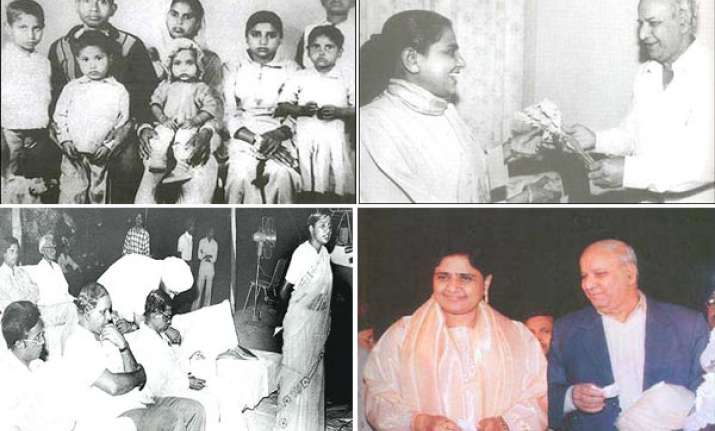


Latest Comment
Now EVM are correctProud To Be Indian